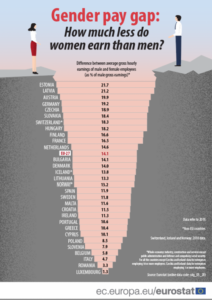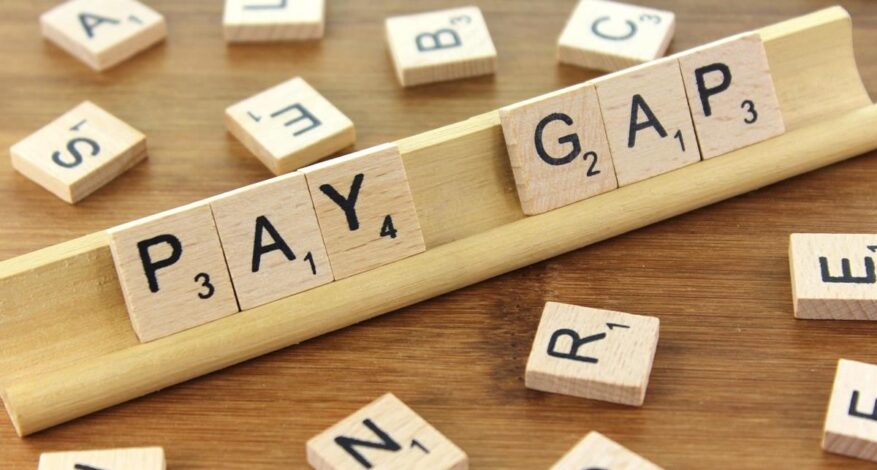WHERE DO WE STAND ON GENDER PAY GAP IN 2021?
Inequality at work
How much is the work of a woman worth? Although the obvious answer should be ‘just as much as that of a man’, data suggest that we are still far from reaching gender equality in the workplace.
As a recent report by the European Commission has revealed, in 2020, on average, women in the European Union earned 14.1% less per hour than men did: this means that, for every euro that was paid to a man, a woman was remunerated €0.86 only. This translates into 51 days of unpaid labour for female workers. In the United States, where this value stands at $0.82 on average (with significant oscillations when ethnicity is taken into account), next 31st March will mark the Equal Pay Day, the day when, virtually, all women will earn the same amount of money that men made by the end of 2020. These striking data are known as the gender pay gap, a useful tool to detect persistent inequality at work.
What is the gender pay gap?
 The gender pay gap is the difference between the average hourly earnings of women and men before tax deductions. As a general indicator, it does not take into account variables such as working hours or type of job: it aims to calculate the difference on average. It differs from what is called “equal pay”, which is the principle for which men and women must be paid equally for the same job or for jobs of equal value. In the EU, this has actually been protected by legislation since 1957.
The gender pay gap is the difference between the average hourly earnings of women and men before tax deductions. As a general indicator, it does not take into account variables such as working hours or type of job: it aims to calculate the difference on average. It differs from what is called “equal pay”, which is the principle for which men and women must be paid equally for the same job or for jobs of equal value. In the EU, this has actually been protected by legislation since 1957.
What the gender pay gap highlights are that, despite all the efforts to end this discrimination, women’s work is still largely undervalued and, therefore, underpaid.
The range of this gap changes as one moves across the globe, and there are significant differences also within the EU, with countries, such as Estonia and Latvia, having the widest gap (over 20%) and others, Luxembourg, Romania, and Italy for instance, the narrowest (under 5%). Yet, lower values do not necessarily mean more gender equality. Actually, they are usually the result of fewer women participating in the workforce. Conversely, higher values are often due to a high number of women working in low-paying sectors or having part-time employments.
What causes the gender pay gap?
 Discrimination, career breaks, the uneven distribution of women across different sectors, and their difficulty to break through the glass ceiling are all phenomena to be blamed for the gender pay gap.
Discrimination, career breaks, the uneven distribution of women across different sectors, and their difficulty to break through the glass ceiling are all phenomena to be blamed for the gender pay gap.
As reported by the European Commission, a lot more women than men work part-time or take time off their careers to care for others (such as children and the elderly): this counts as unpaid labour which often halts professional progression. Besides, women are overrepresented in low-paying jobs, such as cleaning or primary education, and, worryingly, underrepresented in managerial positions or high-paying sectors. In science and technology, for instance, men still account for more than 80% of the workforce. This is not due to a lack of education: women are more likely than men to get university degrees, yet science-related careers still seem to be considered ‘masculine jobs‘, a dangerous misconception that prevents women from accessing opportunities in similar sectors as well as in top-paying positions.
During 2020, women have also been particularly affected by the outbreak of COVID since retail and hospitality — which have been hit extremely hard — are female-dominated sectors. With schools closing and children being confined at home, many mothers have also been forced to sacrifice hours of paid work for childcare. As a result, the UN Women has foreseen that the pandemic will make 47 million women and girls fall under the poverty line worldwide.
Closing the gap
Over the last eight years, the gender pay gap has shrunk by less than 2%. Some experts have estimated that should this trend remain steady, it will take approximately 60 years to close the gap in the EU. But Věra Jourová, the Vice President of the European Commission for Values and Transparency, has been less optimistic: in a statement issued for the European Commission, she declared that “at the current rate, it would take decades, or even centuries, to achieve equality”. A claim backed up by experts at the World Economic Forum, who don’t expect the gap to be closed before the next 202 years.
Clearly, gender inequality has a social cost, but it also weighs heavily on the economy: in 2018, the gender pay gap cost the European Union a whopping €320 billion. Inequality is thus a burden on everyone, but it is time that women stop paying the price for it.


